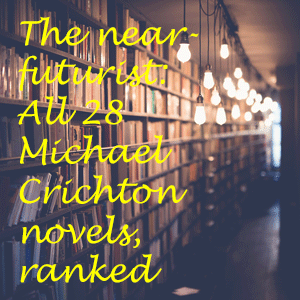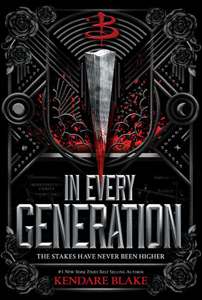First, the elephant in the room. “Buffy: In Every Generation” (January, hardcover) takes place in an alternate timeline – in almost-present day, but with “Angel” Season 5 (2003-04) being the most recent events we know about. Every major article reporting on this book – the first “BTVS” tome since Kiersten White’s Nina the Vampire Slayer duology of 2019-20 – lacked this information, and it’s more than a little frustrating that I had to read the novel to find it out.
New timeline, new trilogy
“IEG” is the first of a trilogy, and I’m impressed by Kendare Blake’s writing to the point where I believe she’s smart enough to fold this story back into the Season 8-12 comics (into which the Nina duology fits). But I doubt “Buffy’s” new Disney overlords plan to let her do it.
At the same time, it seems weird to launch a new Joss Whedon-less “Disney the Vampire Slayer” canon in book form rather than TV form. For now, this is an alternate timeline story — like the “Wicked Willow” trilogy from back in the day.

“Buffy the Vampire Slayer: In Every Generation” (2022)
Author: Kendare Blake
Series: Frankie the Vampire Slayer No. 1
Setting: An alternate timeline in Fall 2020, springing from “Buffy” Season 7, when Willow’s Scythe spell has the side effect of making her pregnant. “Angel” Season 5 marks the last of the established continuity referenced.
So now you know, and now we can move on to Blake’s novel. (SPOILERS FOLLOW.) “IEG” is the first next-gen “Buffy” story (although maybe the Boom! comics alternate timeline counts in a way). We meet Frankie, the teenage daughter of Willow (the birth mother) and the essence of the First Slayer (the father? or other mother?). So Frankie is a Chosen One in “Buffy” terms and in “Star Wars” terms — immaculate conception.
Frankie gains her Slayer powers when an explosion kills all (most? some?) active Slayers at the Slayerfest ’20 meeting (not to be confused with the Slayerfest ’98 hunt) in Nova Scotia.
Gen-Z Scoobs
Blake does an awesome job building this Gen-Z Scooby Gang. Frankie’s arc is familiar – gaining confidence yet accepting help from her friends – but her personality and traits are distinct from “Aunt” Buffy. Granted, Buffy – despite being a cheerleader — isn’t the height of athleticism upon being called, but she is more physically substantial than Willow’s daughter, who is willowy.
Amusingly (but also seriously), Frankie stakes herself in the leg on her first patrol. She works to develop her Slayer skills and her magic skills, and to use them in synch. Her favorite weapon is a long staff – like Donatello’s bo – but with one end carved to a point for staking.

Vi (played by geek icon Felicia Day) might’ve fit this physically unimposing, awkward bill back when she was a Potential in Season 7. But now she is a kickass Slayer, as we know from her Watcher Spike and her kid sister Hailey. So Frankie is a great lead for this story not only because she’s Willow’s daughter but also because she’s a fresh Slayer type.
Rounding out the new Scoobs are Hailey; Jake, werewolf cousin-nephew of Oz; and Sigmund, a handsome half-Sage demon who draws energy from others’ stupidity. With Vi feared dead in the explosion, Spike steps in as Frankie’s Watcher. Powerful demon Grimloch is Frankie’s mysterious outside helper.
Like Sigmund, Grimloch is described as devastatingly handsome. Frankie also notices that Jake, while “annoying,” ain’t so bad looking. It’s amusing and refreshing to get the female gaze here. A lot of past “Buffy” works – while feminist in legitimate ways – are told via the traditional male gaze of the horror genre.
Welcome to New Sunnydale
All of this takes place in New Sunnydale. This allows Blake to position these new teens against the same backdrop of a town that pretends vampires don’t exist; hence we can focus on what makes the characters different from the OG Scoobs. (“IEG” also pares down the comics’ scope of the Slayer army being a worldwide force; they seem secretive here. So maybe we’re back to the supernatural being largely unknown by the populace.)
As Blake notes in her acknowledgements, with the high value of coastal real estate, Sunnydale was inevitably going to be redeveloped. I agree, but I want to know how the town got rebuilt so fast, considering California building codes. But I’m fine with this info coming in future books.
About a third of the way through this 400-pager, I realized I like these new characters enough to set aside my logistical questions. Granted, the idea that Willow, Spike and Oz did nothing remarkable in 17 years, rather than having the life-changing, world-hopping adventures in the comics, is irksome. And while I wouldn’t say these original heroes are out of character, they are second fiddles.
This is purposeful by Blake. It would be so tempting to write a Spike-and-Willow adventure, with the teens looking on and learning. Blake avoids this trap and focuses on the teens. She gets away with it by making Frankie and Friends distinct, realistic and likable.
Worthy villains
The author writes like a novelist but thinks like a “Buffy” TV scribe. For example, she notes that Willow uses magic to make Spike look older, befitting the librarian he now is. That’s not necessary unless a writer is thinking of how to have James Marsters reprise the role.
“IEG” unfolds smoothly, but more like a TV season than an episode (White’s books also have this quality). For instance, there’s a mid-novel diversion about a Succoro demon, which can mesmerize girls into peeling their skin off. Blake is a good writer of gore-horror, as seen again in the final showdown.
Ultimately, The Countess emerges as a worthy “Season 1” Big Bad for Frankie. Because of her insistence on only drinking virgins’ blood, The Countess (who, intriguingly, springs from the real-life Elizabeth Bathory) has traits not found in most vampires. A staking doesn’t kill her, for starters.
Blake does a standout job writing fights. In a lot of “Buffy” books, the action incongruously “slows down” during fight scenes as we absorb every punch and kick. This author knows what details to include (such as Frankie’s staff) and what to skim over. I also like the gang’s strategies, especially their use of mirrors to reflect sunlight in a key battle against underground vamps.
Staking down the details
Blake excels at the little things that make a “BTVS” novel a rich experience, from Frankie’s choice of clothes when patrolling, to what she’s having for meals (she’s a vegan), to the local buzz surrounding two upcoming dances.
The author gets a passing grade at “Buffy”-speak. She avoids the three traps some Whedon-verse writers fall into: putting quips into the prose itself, slathering pop-culture references in the text, and trying too hard in the dialog. Blake’s exposition is crisp and straightforward, and the occasional cultural reference doesn’t derail the flow.
Blake gives more nods to events from the “Buffy” TV series than to the wider world, but they are subtle. The way the near-immortal Countess has to be dispatched parallels a previous villain, but Frankie and Friends don’t talk about the connection all day.
Our heroes’ quips flow naturally from their personalities and situations. Interestingly, new gal pals Frankie and Hailey don’t initially have rhythmic repartee; they trade bad jokes about menstruation (Do girls really casually joke about that?).
Gradually, their chatter starts to sing, yet Blake isn’t mimicking Nineties “Buffy”-speak nor bluntly inventing 2020s Frankie-speak. Everyone sounds like smart yet developing Gen-Z teenagers, and in tense situations (or the aftermath) they say amusing things off the cuff.
Ongoing questions
Playing behind “IEG’s” A-plot are more expansive mysteries. The big one is: Are all the Slayers dead? Secondarily: Who is the Slayer who Grimloch is in love with? A third mystery comes via a key character’s return in the final pages.
Playing as yet another layer is what I brought up at the start of this post: Does this story somehow fit into the same continuity as Season 8-12? Portals, dimensions and magic are part of the Buffyverse, after all.
The appearance of Dawn at the end of the Season 5 premiere pops into my head. We speculated about how Buffy can suddenly have a kid sister and everyone is acting like she’s been there all along. Subsequent episodes parsed out answers.
In “IEG,” though, the issue is not the appearance of one new person, but the fact that we’re in a new timeline that branched off with Willow’s Scythe super-spell. It’s a bigger deal. Blake does not pepper clear multiverse clues into the narrative, so the Dawn parallel doesn’t click.
Based only on “In Every Generation,” I’d guess Blake’s trilogy is a plain ole alternate continuity. I’m not a fan of that; I would’ve preferred the narrative pick up after Season 12 (which would also be in present day, but would require monk magic to give a teen daughter to Willow).
But I am a newly minted fan of Blake’s smooth writing, her grasp of the Buffyverse, and her ability to make Frankie’s journey feel as urgent as Buffy’s.

